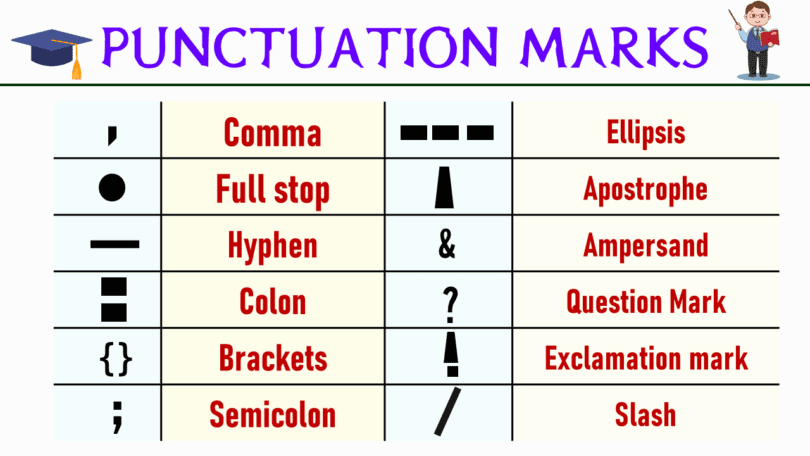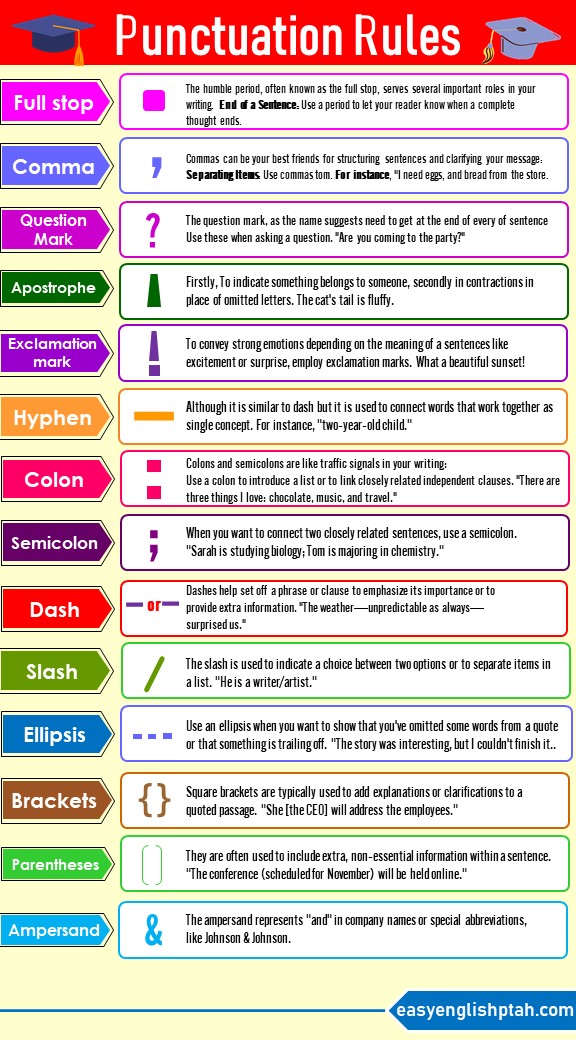Punctuation marks are used to emphasize our written English. Many English Learners are quite Confused about how to use Punctuation Marks correctly. if you wish to make your writing effective, you must learn punctuation marks. Below, I have explained all punctuation marks along with their usages and examples so that you can understand them well and improve your writing easily.
Punctuation Marks
- Period
- Comma
- Question Mark
- Exclamation Mark
- Apostrophe
- Quotation Marks
- Colon
- Semicolon
- Hyphen
- Em Dash
- Parentheses
- Brackets
- Ellipsis
- Slash
- Ampersand
- At Symbol
Punctuation Marks with Examples
1. Periods (.)
This sign is referred to as the full stop, it functions several important roles in your writing:
- End of a Sentence:
We Use a period at the end of a sentence to tell the reader about a complete thought
For example, I love to read books. - Abbreviations:
There are common abbreviations like Mr., Mrs., and Dr. are always followed by a period.
2. Commas (,)
Commas can be used for structuring sentences and clarifying your message:
- Separating Items:
You can use commas to separate items in a list.
For instance, I need eggs, milk, and bread from the store. - Introductory Phrases:
Commas can help introduce a sentence.
‘Before we start, let’s prepare our materials. - Appositives:
When you provide extra information about a noun, you need to begin with commas.
My friend, the artist, will join us.” - In a Series:
If you have a series of adjectives, phrases, or clauses, use commas to separate them.
We visited Paris, Rome, and Barcelona on our vacation.
3. Question Marks (?) and Exclamation Marks (!)
These punctuation marks are used to express questions and strong emotions:
- Question Marks:
Use these sign when you want to ask a question.
Are you coming to the party? - Exclamation Marks:
If you want to convey strong emotions like excitement or surprise, you should use exclamation marks.
What a beautiful sunset!
4. Apostrophes (‘)
Apostrophes are used to show that a letter has been left out in a sentence or to show ownership or contractions. They function the following purposes:
- Possession:
To indicate that something belongs to someone, use an apostrophe.
The cat’s tail is fluffy. - Contractions:
When two words are combined to shorten them,
such as ‘Can’t for cannot, an apostrophe is used to take the place of missing letters.
5. Quotation Marks (” “)
Quotation marks are used to identify direct speech or quotes:
- Direct Speech:
Whenever someone speaks, you should cover their words in quotation marks.
She said, ‘I’ll be there soon. - Quotes:
When you include a famous saying or someone else’s words, use quotation marks.
Albert Einstein once said, ‘Imagination is more important than knowledge.
6. Colons (:) and Semicolons (;)
Colons and semicolons can be used alternatively. Both are used to introduce Something such as ‘Quote’
- Colons:
You can use a colon to introduce a list or to link closely related independent clauses.
There are three things I love: chocolate, music, and travel. - Semicolons:
When you want to connect two closely related sentences, use a semicolon.
Sarah is studying biology; Tom is majoring in chemistry.
7. Hyphens (-) and Dashes (—)
Hyphens and dashes are used to add clarity and emphasis in a sentence.
- Hyphens:
They are used to connect words that work together as a single concept.
For instance, ‘two-year-old child.’ - Dashes:
Dashes are used to start a phrase or clause to emphasize its importance or to provide extra information.
The weather—unpredictable as always—surprised us.
8. Parentheses ( ) and Brackets [ ] These two marks are used to describe additional information:
- Parentheses:
They are often used to include extra, non-essential information within a sentence.
The conference (scheduled for November) will be held online. - Brackets:
Square brackets are generally used to add explanations or clarifications to a quoted passage.
She [the CEO] will address the employees.
9. Ellipses (…) and Slashes (/)
These marks are used to indicate omission or choice:
- Ellipses:
You can use an ellipsis when you want to show that you’ve omitted some words from a quote or that something remains less in amount.
The story was interesting, but I couldn’t finish it… - Slashes:
The slash is used to indicate a choice between two options or to separate items in a list.
He is a writer/artist.
10. Ampersand (&) and the At Symbol (@)
These two symbols have the following specific uses:
- Ampersand:
The ampersand is used to represent ‘And’ , Further it is used in company names or special abbreviations,
like Johnson & Johnson. - At Symbol:
The ‘AT ‘symbol is commonly used in email addresses,
such as info@example.com.
Special Typographic Conventions
| Convention | Description |
|---|---|
| Italics | Used for emphasis, titles, or foreign words. |
| Bold Text | Adds emphasis or highlights important information. |
| Underline | Rarely used today; often substituted by italics. |
| Monospace Font | Used for code, URLs, or to indicate computer input. |
You May Also Like






